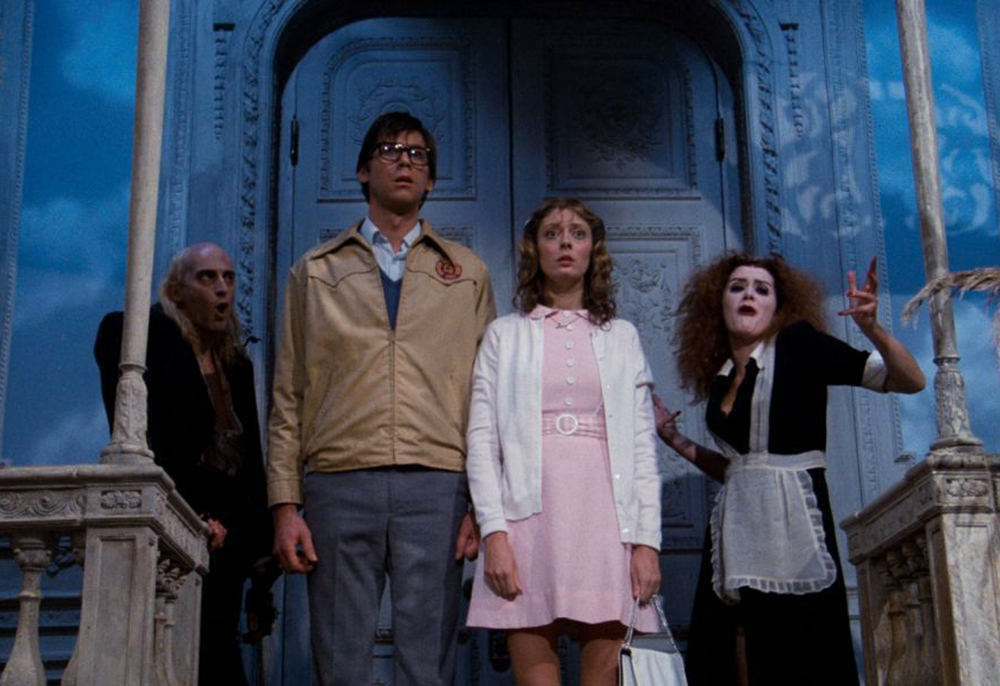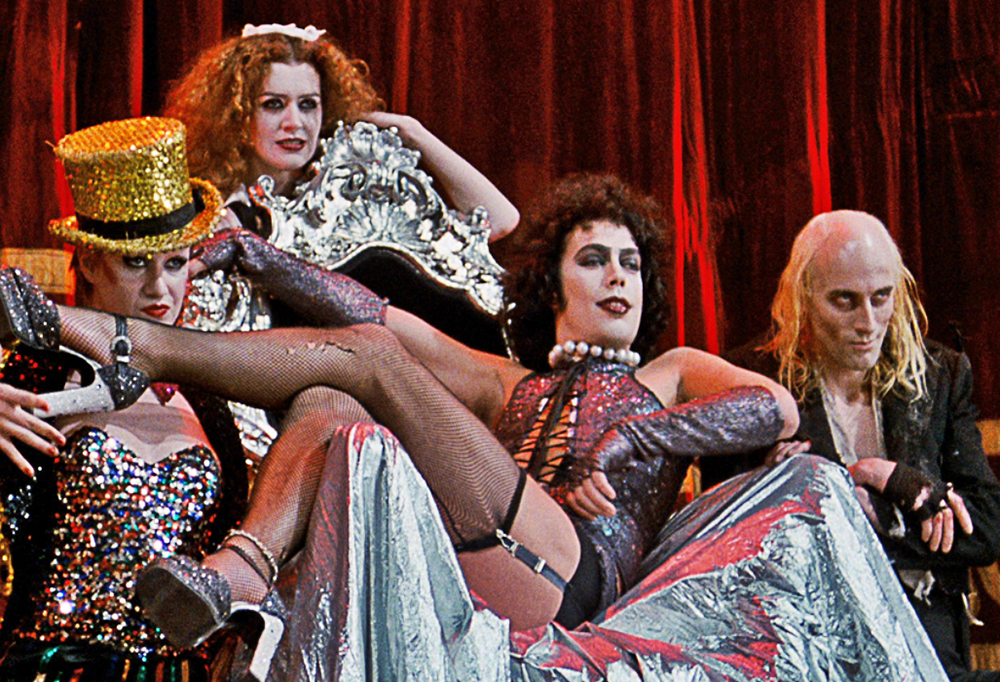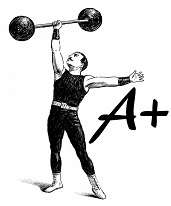In the classic horror/musical “The Rocky Horror Picture Show,” one stormy night, Janet and Brad, a newly engaged and chaste couple, find themselves at the mercy of an extraterrestrial, eccentric, and sexually-liberated scientist named Dr. Frank-N-Furter. Along with him are his equally odd group of assistants, Riff Raff, Columbia, and Magenta—who, much like their master, are obsessed with playing some mind games at the expense of their simpleminded house guests.
While it is doubtful whether our unsuspecting couple will emerge untainted from Frank-N-Furter’s castle of unimaginable and inconceivable horrors, the messages conveyed by this campy cult classic certainly have endured the test of time and remain uncorrupted. In fact, many of them still ring true, even in the 21st Century.
It is also not surprising that the movie has proved to be a hit with the LGBTQIA+ community long since its theatrical release four decades ago. A majority of the imagery featured is right on the nose in highlighting the oppression faced by the LGBTQIA+ community, and also aids in breaking stereotypical gender norms that many in society are still forced to conform to. It also sheds light on problematic patriarchal mindsets that have set back the progress of the human race.
An Identity-Affirming Picture Ahead of its Time
There are many instances of queer-coded imagery throughout, such as the prop rainbow-tinted glass enclosure Frank-N-Furter utilises for his bizarre experiments. There’s also a literal appearance of a rainbow in the sky. The most bold is the inverted triangle visible on one of Frank’s outfits, a reference to similar signage used in Nazi concentration camps as means of branding ‘femme’ or gay prisoners. In recent times, it has been reclaimed by the gay community.
However, “Rocky Horror’s” biggest positive is its humane picturisation of the Transylvanian transexual/transvestite lead, Dr. Frank-N-Furter himself. While Frank’s far from saintly, screenwriter Richard O’Brien (who himself identifies as transgender) must be lauded for choosing not to overly vilify this character either. This was the unfortunate case with the problematic “Myra Breckenridge,” a movie released just five years prior. The distasteful “Myra Breckenridge” faces scrutiny to this day from the trans community for piling adding to growing transphobia by vilifying and glorifying its titular trans protagonist’s violent and abusive behaviour towards male suitors.

On the other hand, Frank-N-Furter comes across as a contrast to Myra Breckenridge due to his depiction as an anti-hero. He’s an outsider whom audiences can feel compassion for or gravitate towards. His grotesque acts stemmed from a twisted and highly-uninformed perspective regarding human emotions, such as romantic attachment. This—as well as his failure in differentiating between societal concepts such as patriarchy and toxic masculinity—lead to him confusing the latter for romantic cravings instead. His loneliness and yearning only worsens his muddled thought process. However, ultimately he and his human counterparts (Brad and Janet) are display a mutual desire to rise above their limited knowledge through rather kinky and unorthodox interactions with each other.
Tim Curry Brings his Stage Creation to the Big Screen
To be perfectly frank (pardon the pun), while on the surface “The Rocky Horror Picture Show” may seem like your typical goofy and larger-than-life musical, upon closer examination it reveals itself to be a social satire on the human condition. It can even be seen as a guide in self-acceptance. It teaches the audience lessons on just being yourself, rather than forcing oneself into a man-made prison, adhering to societal expectations or fixed gender norms.
As science fiction ultimately collides with reality, the movie also breaks the fourth (or maybe fifth?) wall and forces its audience to reflect upon these very issues. The audience experiences these in a similar manner to which “Rocky Horror’s” characters confront their own respective fears and challenges on-screen. For example, either by crying out in anguish (such as the closeted Brad confronting his underlying Oedipus complex) or Frank-N-Furter singing about his conflicted and troubled mindset in the manner of a caged bird.
Tim Curry, who originated the role of Dr. Frank-N-Furter in the stage musical (and who made his big screen debut with this adaptation) plays the character with all the gusto and flourishes of a seasoned stalwart of the stage. He brings to the table a wide range of facial expressions; he’s at his playful best as a mischievous and raunchy lothario who wears his heart on his sleeve. He simultaneously and effortlessly strikes fear (and later on, elicits pity), as he jarringly shifts into a misunderstood mad scientist who is often oblivious to his own fits of jealousy and rage-induced abuse.
Curry Wows; the Supporting Cast Equals His Magic
Despite the character’s many flaws, the talented Curry more often than not ends up stealing the show—and also some hearts. Considering he shares screen space with talented and already established actors such as Susan Sarandon and Barry Bostwick (who star as Janet and Brad respectively), this is a feat in itself. His impeccable comic timing and exaggerated intonation in delivering cheeky wisecracks and sassy comebacks leaves one in splits. Curry also deserves a round of applause for carrying himself with grace during the physically demanding scenes, such as chasing after Susan Sarandon and Peter Hinwood wearing towering platform heels!

The late singer Meat Loaf (also part of the original stage cast) appears in a brief but pivotal role as singing biker Eddie. He, too, delivers a performance that can be best described as ‘nothing short of rock ‘n’ roll.’ The supporting cast of Richard O’Brien, Nell Campbell, and Patricia Quinn are terrific in their respective roles as Frank’s assistants. Campbell, as the high-pitched Columbia almost threatens to steal the spotlight from Curry in the second half. This is particularly during her character’s emotionally charged breakdown as she lashes out against Frank for his selfish and quasi inhumane treatment of his in-house staff and guests.
The soundtrack by Richard Hartley and Richard O’Brien is not only an ear worm and a staple at house parties, but the lyrics also effectively encapsulate the themes featured in the movie, while also acting as a brilliant storytelling device one never tires of listening to. Speaking of storytelling devices, the dinner table scene is a masterclass in utilising awkward pauses to the fullest and in executing jump scares well. Film schools worldwide should probably incorporate it into the curriculum immediately.
‘Rocky Horror’—a Method to Its Madness
Lastly, the musical sensibilities of the lively cast further enhance the ambitious compositions and dance numbers, and the cinematography by Cronenberg regular, Peter Suschitzky also provides for some arresting visuals. Even if the movie chooses to focus on some of humanity’s ugliest facets, it is still visually breathtaking.
There is definitely a method to the madness in “The Rocky Horror Picture Show,” as long as one can view this ‘sensual spectacle’ with an open mind and without their own preconceived notions. As the riveting Dr. Frank-N-Furter puts it, “Just give yourself over to absolute pleasure!” Time is fleeting, so if you haven’t yet, do go and lose your “Rocky Horror” virginity right away!
“The Rocky Horror Picture Show” is available to stream, rent, or buy from most networks.
Support the Site: Consider becoming a sponsor to unlock exclusive, member-only content and help support The Movie Buff!


